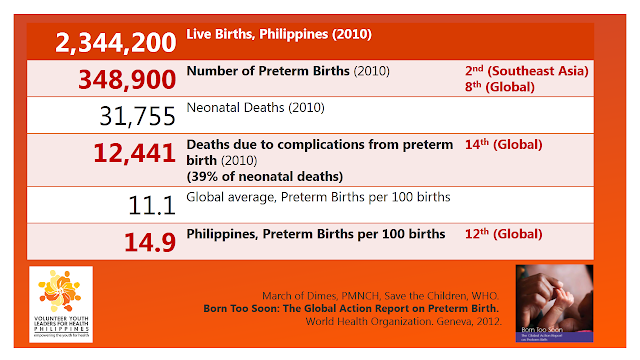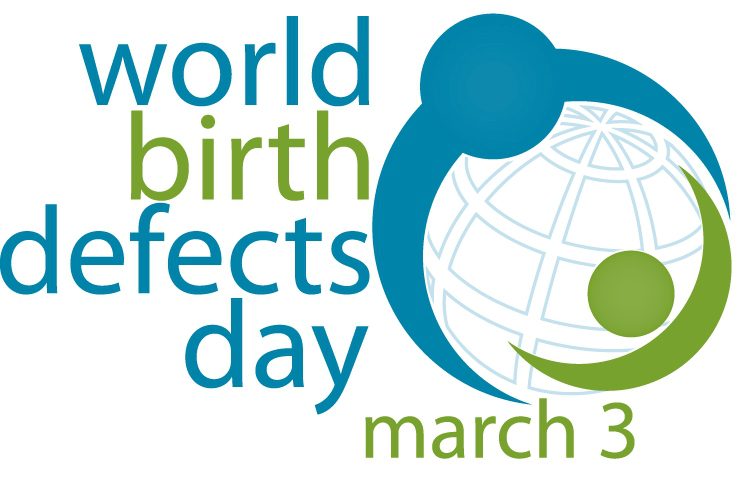Prematurity
Awareness Month and
World Prematurity Day Primer
This 2015,
VYLH-Philippines welcomes a new partner in the advocacy - the Philippine Society
for Newborn Medicine (PSNbM), a sub-specialty society of the Philippine
Pediatric Society (http://www.psnbm.org.ph/). The PSNbM is an organization of
board-certified neonatologists who are firmly committed to establish promote
sand provide a continuum of care of the highest standard for all newborn
infants. Early this year, PSNbM launched #HingaHingalo ni Baby a movement set
to forge partnerships between various stakeholders in the health sector, in
educating the public about prematurity, its implications, and available
interventions.
PSNbM together with its partners sponsors “Prematurity Awareness Month” this November and this aims to help in focusing the nation’s attention on premature births and bring
people together on raising awareness on the global problem due to preterm
births. Prematurity Awareness Month is also practiced in the United States and promoted by the March
of Dimes (MoD), a leader in the awareness campaign for preterm
births. MoD launched its campaign in 2003 (http://www.marchofdimes.org/).
#WorldPrematurityDay (Nov. 17)
The global event takes place across the world every November 17. According to the WHO and March of Dimes, #WorldPrematurityDay is a crucial moment to reflect and commit to action to help address the inequities in preterm survival between low and high-income countries, and to prevent unnecessary deaths and health problems caused by preterm births.
In 2008, the idea
to create an international awareness day for preterm infants and their families
was conceived during the first meeting of European parent organization
organized by European Foundation for the Care of Newborn Infants (EFCNI).
During the same year, the March of Dimes launched its Prematurity Awareness
Month in the United States. The first international day for preterm births was
first celebrated in 2009. The event was celebrated by a greater number of
countries outside the region, hence the adoption of World Prematurity Day in
2011.
Based from the
EFCNI website, more than 200 countries participated in activities, and more
than 60 countries planned special events for World Prematurity Day. It was
estimated that 1.6 billion people around the globe were reached by the campaign
in 2014.
Quick Facts on
Preterm Births
- Prematurity is the leading cause of newborn deaths, and second-leading cause of death in children under the age of 5 (after pneumonia)
- Preterm/Preemies/Premmies are babies born alive before 37 weeks of pregnancy are completed.
- 1 in 10 babies are born premature, worldwide
- 15 Million babies are "born to soon" every year and the numbers are rising
- Almost 1 million children die each year due to complications of preterm birth
- Babies who survive often have long-term health problems, including cerebral palsy, intellectual disabilities, chronic lung disease, blindness, and hearing loss.
- More than 60% of preterm births occur in Africa and South Asia, but preterm birth is truly a global problem.
- Babies born between 32 and less than 37 completed weeks of pregnancy (Late Preterm) make up 85 percent of the 15 million preterm babies born annually – 12.6 million. Late Preterm babies have a good chance of survival if the basic, low cost interventions are in place.
- More than three-quarters of premature babies (>75%) can be saved with feasible, cost-effective care such as essential newborn care, antenatal steroid injections to pregnant women at risk of preterm labor; provision of antibiotics to newborns; and, kangaroo mother care.
Compiled from the World Health Organization and the March of Dimes.
Preemies in the
Philippines
The Philippines
ranks…
- 2nd in the number of premature births in Southeast Asia.
- 8th in the number of premature births worldwide.
- 12th in terms of preterm births per 100 births (preterm birth rate).
- 14th in terms of deaths due to complications from preterm birth worldwide.
- Deaths due to complications of preterm birth account to 39% of neonatal deaths.
This is according
to “Born Too Soon: The Global Action Report on Preterm Birth”, the first global
report which provided national, regional and global estimates of preterm
births. The report published in 2012 was produced by the March of Dimes, The
Partnership for Maternal, Newborn & Child Health, Save the Children and the
World Health Organization in support of the UN's Every Woman Every Child effort.
Napaagang
Panganganak: Alamin. Sagipin. Kalingain.
(A.S.K. Dok!)
(A.S.K. Dok!)
For the promotion
of public awareness on preterm births, VYLH-Philippines adapted PSNbM’s Prematurity
Awareness Month theme,"Napaagang Panganganak: Alamin. Sagipin. Kalingain." (Preterm Births: Know. Save. Care.). The theme is grounded on the need to
instill to the Filipino society the importance of consulting our doctors on health
concerns and issues, hence “A.S.K. Dok!”. Since pregnancy is a delicate
condition, it is of great importance for expectant mothers to be fully aware of
their needs, the baby’s needs, potential risks, and strategies in improving the
outcome of the pregnancy – especially on preventing preterm birth and possible
complications of preterm births.
Alamin (Know)
Even though a pregnant mother does everything right, preterm labor is still a posibility. Preterm labor means that the baby is starting to be born early, before nine months of pregnancy. It is important that expectant mothers should know that:
- Babies born to early may have more health problems or need to stay in the hospital longer.
- The specific cause of preterm birth is not yet clear. However, there are factors that may increase the risk of preterm birth such as
- previous preterm pregnancy
- multiple pregnancy (twins, triplets etc.)
- a short interval between pregnancy (>6 months)
- problems with the uterus, cervix or placenta,
- smoking and illegal drug use,
- poor nutrition,
- some infections in the placenta or urinary tract,
- chronic conditions such as high blood pressure and diabetes,
- being underweight or overweight before pregnancy
- stressful live events
- multiple miscarriages or abortion
- physical injury or trauma
- Learning the signs of preterm labor may help you keep your baby from being born to early.
 |
| Get a copy of our "Signs of Preterm Labor Brochure" Download (DOH. IHG, MoD) |
- Contractions for every 10 minutes, or more often
- Bleeding or change in the color of vaginal discharge
- Feeling that the baby is pushing down (pelvic pressure)
- Low, dull backache
- Cramps, similar to menstrual cramps
- Belly cramps with or without diarrhea
- Elective non-medically indicated delivery of the baby before the 39th week of pregnancy is not recommended. (Remember: Health Babies are Worth the Wait(R)). Here are some reasons:
- Your baby’s brain, eyes, ears and lungs are still developing in the last few weeks of pregnancy.
- A baby’s brain at 35 weeks weighs only two-thirds of what it will weigh at 39 to 40 weeks.
- Remember, your due date is an estimate. It could be off by a week or two.
- In case any of the signs of preterm labor is felt (even only one) and it doesn't go away, it is important to call a doctor or healthcare practitioner, or go to a hospital.
- Try not to worry too much.
- Getting help quickly is the best thing you can do.
Sagipin (Save)
 |
| Saving Preemies (TIME, May 2014) |
Cutting-edge medicine and dedicated healthcare providers are helping preemies survive. Medical advances have helped improved survival and long-term health for babies born as early as 22 weeks. There are also feasible, cost-effective interventions that can save more than 75% of premature babies such as:
- Essential care during child birth and in the postnatal period for every mother and baby;
- Antenatal steroid injections given to pregnant women at risk of preterm labor and to strengthen the babies’ lungs);
- Kangaroo mother care - the baby is carried by the mother with skin-to-skin contact and frequent breastfeeding); and
- Antibiotics to treat newborn infections.
Kalingain (Care)
The newborn's basic needs are warmth, nutrition, protection & stimulation.
- Kangaroo Mother Care (KMC) is a high-impact, cost-efficient intervention that has proven effective in saving the lives of premature/LBW newborns.
- KMC is the early, prolonged and continuous skin-to-skin contact between the mother (or adult substitute) and her baby—both in hospital and after discharge—with support for feeding (ideally exclusive breastfeeding) and close follow-up after early discharge from the hospital.
- This approach helps regulate the baby’s body temperature, facilitates early initiation of and continued breastfeeding, reduces the risks of infection, and enhances brain growth and development.
Reduce
preventable deaths among newborns. “Prematures represent one of the most vulnerable
population of Filipinos”. This is according to Dr. Anthony Calibo of the Child
Health Development Division – Disease Prevention and Control Bureau (DOH). During
the launch of #HingaHingalo, Dr. Calibo noted that interventions can be done
while the baby is still in the womb and the moment when they are born. The campaign
on prematurity awareness will also contribute in the reducing newborn deaths.
The 2013 National Demographic and Health survey reveals that newborn deaths
were reduced from 18 per 1000 in 1998, 16 in 2008 and down to 13 deaths in
2013. As Dr. Calibo called for continuous action beyond the 2015 Millennium
Development Goal, he mentioned that “reducing child mortality is an unfinished
business, and we still have a long way to go to really ensure that no newborns
die. Their deaths can be prevented, and with your help, we can ensure that more
children survive the complications preterm births bring.”
Everyone has a
role. According to former PSNbM President Carina Quimbo, the number of neonatologists
are not enough in the country. From the 89 certified neonatologists, 50 percent
are in Metro Manila hence making it difficult to cover all areas in the
country. Quimbo added that newborn survival doesn’t depend on doctors alone.
Doctors (neonatologists, obstetricians and other specialties), the allied
medical professions, national agencies such as PhilHealth and DOH should work
hand-in-hand in addressing the problem.
___________________
Philippine Star. #HingaHingalo
ni Baby gives prematures a chance. 02 March 2015. https://sg.news.yahoo.com/hingahingalo-ni-baby-movement-gives-000000385.html





















